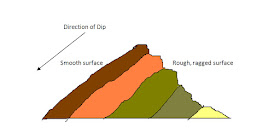The analysis of aerial photographs in photogeology is done using the same elements of interpretation. "Tone" is used in the identification of rock type. Generally lighter tones indicate rock types like Quartzite. Tone is also used in the identification of the density of vegetation which in turn provides clues about the underlying rock. Usually dense vegetation can be seen in area where the rock Khondalite is present and in areas where Quartzite is abundant, very little or no vegetation is present.
By using a stereoscope to view the three dimensional topography of the area structural features such as ridges, valleys and slopes can be identified. Due to differences in hardness and the extent of weathering, certain rock types show characteristic structural features. For example, Marble and Hornblendebiotite Gniess are found at the bottom of valleys because they are highly prone to weathering. Rocks that are much harder and are resistant to weathering like Quartzite, Granite and Granitic Gneiss usually form ridges.
 |
| geological features in an aerial photograph |
When viewing outcrops from above, for example in a ridge like structure, by looking at the texture on either side of the ridge, the direction of dip and strike can be inferred. Since the side where multiple layers of rock are exposed undergoes differential weathering that side become ragged and rough. This side is termed the escarpment face. The side on which a single layer of rock is exposed undergoes uniform weathering and therefore is relatively smooth. This side is the Dip slope. Therefore, generally the side of a ridge that has a relatively smooth texture indicates the direction of dip.
 |
| cross section of a ridge |
The drainage pattern and shapes of marshes lakes etc also provide clues about the geological structure of the area. A drainage pattern like shown in the first diagram indicates a homogeneous and relatively flat rock while a pattern like in the second diagram indicates a highly jointed rock. In addition to this, the displacement of any feature along a line indicates a rock fault.
Once all possible features are identified form the aerial photograph, a geological map of the area is plotted. This map is referred and then the data is confirmed by using field data.




